Changes in the Function of Allotment Gardens in an Attractive Location Based on the Example of Tri-City in Poland
Abstract
1. Introduction
2. Materials and Methods
3. Scientific Background
3.1. Review of Research on Allotment Gardens
3.2. Conceptualization of the Idea and Records of the Functions of Allotment Gardens in Poland
3.3. Case Study—Allotment Garden in Tri-City
3.4. Changes in the Function of Allotment Gardens in Tri-City
4. Results
4.1. “ROD Oaza” as an Example of Allotment Gardens in a Prestigious Location
4.2. Unauthorized Construction
4.3. Surveys on the Perception of Allotment Gardens
4.4. Opinions of the Owners of Traditional Allotment Gardens on Changing Their Functions
5. Discussion and Conclusions
Author Contributions
Funding
Conflicts of Interest
References
- Keshavarz, N.; Bell, S. A history of urban gardens in Europe. In Urban Allotment Gardens in Europe; Bell, S., Fox-Kämper, R., Keshavarz, N., Benson, M., Caputo, S., Noori, S., Voigt, A., Eds.; Routledge: New York, NY, USA, 2016; pp. 8–32. [Google Scholar]
- Rusanov, A. Dacha dwellers and gardeners: Garden plots and second homes in Europe and Russia. Popul. Econ. 2019, 3, 107–124. [Google Scholar] [CrossRef]
- Grebler, L. Urban Renewal in European Countries. J. Am. Inst. Plan. 1962, 28, 229–238. [Google Scholar] [CrossRef]
- Camerin, F. From “Ribera Plan” to “Diagonal Mar”, passing through 1992 “Vila Olímpica”. How urban renewal took place as urban regeneration in Poblenou district (Barcelona). Land Use Policy 2019, 89, 104226. [Google Scholar] [CrossRef]
- Álvarez Mora, A.; Camerin, F. La herencia del urban renewal en los procesos actuales de regeneración urbana: El recorrido Renovación-Regeneración a debate. Ciudad Territ. Estud. Territ. (CYTET) 2019, 51, 5–26. [Google Scholar]
- Lees, L.; Phillips, M. (Eds.) Handbook of Gentrification Studies; Edward Elgar Publishing: Glos, UK, 2018. [Google Scholar]
- Lefebvre, H. Le Droit à la Ville; Anthropos: Paris, France, 1968. [Google Scholar]
- Sklair, L. The Icon Project: Architecture, Cities, and Capitalist Globalization; Oxford University Press: Oxford, UK, 2017. [Google Scholar]
- Bellows, A. One hundred years of allotment gardens in Poland. Food Foodways 2004, 12, 247–276. [Google Scholar] [CrossRef]
- Studium Uwarunkowań i Kierunków Zagospodarowania Przestrzennego (SUiKZP) Miasta Gdańska. 2019. Available online: https://www.brg.gda.pl/planowanie-przestrzenne/studium-uwarunkowan-i-kierunkow-zagospodarowania-przestrzennego (accessed on 27 April 2020).
- Studium Uwarunkowań i Kierunków Zagospodarowania Przestrzennego (SUiKZP) Gdyni. 2019. Available online: https://bip.um.gdynia.pl/studium-uwarunkowan-i-kierunkow-zagospodarowania-przestrzennego-gdyni,425/studium-uwarunkowan-i-kierunkow-zagospodarowania-przestrzennego-gdyni,383263 (accessed on 3 May 2020).
- Studium Uwarunkowań i Kierunków Zagospodarowania Przestrzennego (SUiKZP) Miasta Sopotu. 2018. Available online: https://bip.sopot.pl/m,183,studium-uwarunkowan-i-kierunkow-zagospodarowania-przestrzennego.html (accessed on 4 May 2020).
- Bell, S.; White, M.; Griffiths, A.; Darlow, A.; Taylor, T.; Wheeler, B.; Lovell, R. Spending time in the garden is positively associated with health and wellbeing: Results from a national survey in England. Landsc. Urban Plan. 2020, 200, 103836. [Google Scholar] [CrossRef]
- Van der Berg, A.; van Winsum-Westra, M.; de Vries, S.; van Dillen, S. Allotment gardening and health: A comparative survey among allotment gardeners and their neighbors without an allotment. Environ. Health 2010, 9, 74. [Google Scholar] [CrossRef] [PubMed]
- Mourão, I.; Moreira, M.; Almeida, T.; Brito, L. Perceived changes in well-being and happiness with gardening in urban organic allotments in Portugal. Int. J. Sustain. Dev. World Ecol. 2019, 26, 79–89. [Google Scholar] [CrossRef]
- Pitkänen, K.; Lehtimäki, J.; Puhakka, R. How do Rural Second Homes Affect Human Health and Well-being? Review of Potential Impacts. Int. J. Environ. Res. Public Health 2020, 17, 6748. [Google Scholar] [CrossRef]
- Costa, C. Kleingärten—Um componente da infraestrutura urbana: Aspectos urbanísticos, ecológicos e sociais dos jardins arrendados na Alemanha. Urbe Rev. Bras. Gestão Urbana (Braz. J. Urban Manag.) 2012, 4, 103–122. [Google Scholar] [CrossRef][Green Version]
- Drescher, A.; Holmer, R.; Iaquinta, D. Urban Homegardens and Allotment Gardens for Sustainable Livelihoods: Management Strategies and Institutional Environments. In Tropical Homegardens: A Time Tested Example of Sustainability; Nair, P., Kumar, B., Eds.; Springer: Cham, Switzerland, 2006; pp. 317–338. [Google Scholar]
- Dzikowska, A.; Krzemińska, A.; Zareba, A. Allotment Gardens as Significant Element Integrating Greenery System of the City. IOP Conf. Ser. Earth Environ. Sci. 2019, 221, 012121. [Google Scholar] [CrossRef]
- Bartłomiejski, R.; Kowalewski, M. Polish Urban Allotment Gardens as ‘Slow City’ Enclaves. Sustainability 2019, 11, 3228. [Google Scholar] [CrossRef]
- Edmondson, J.; Childs, D.; Dobson, M.; Gaston, K.; Warren, P.; Leake, J. Feeding a city—Leicester as a case study of the importance of allotments for horticultural production in the UK. Sci. Total Environ. 2020, 705, 135930. [Google Scholar] [CrossRef] [PubMed]
- Pourias, J.; Asuero, R.; Aubry, C.; Ducrocq, T.; Zarandieta, J. Urban Associative Gardens in Poor Neighbourhoods of Seville and Paris: Garden Productions and Access to Food; Foundation Carrefour: Massy, France, 2020. [Google Scholar]
- Gagyi, Á.; Vigvári, A. Informal Practices in Housing Financialisation: The Transformation of an Allotment Garden in Hungary. Crit. Hous. Anal. 2018, 5, 46–55. [Google Scholar] [CrossRef]
- Gibas, P.; Boumová, I. The Urbanization of Nature in a (Post) Socialist Metropolis: An Urban Political Ecology of Allotment Gardening. Int. J. Urban Reg. Res. 2020, 44, 18–37. [Google Scholar] [CrossRef]
- Sovová, L.; Krylová, R. The countryside in the city? Rural-urban dynamics in allotment gardens in Brno, Czech Rupublic. Morav. Geogr. Rep. 2019, 27, 108–121. [Google Scholar]
- Jelińska, A. Rodzinne ogrody działkowe—Mikroświat w mieście. Analiza zjawiska na przykładzie Gdańska. In Człowiek i Miasto: Gdańszczanie Między Starą a Nową Tożsamością; Dymarski, Z., Ed.; Wydawnictwo Uniwersytetu Gdańskiego: Gdańsk, Poland, 2017; pp. 121–141. [Google Scholar]
- Dymek, D.; Bednorz, W. Zagospodarowanie rodzinnych ogrodów działkowych (ROD) na przykładzie ROD im. Józefa Chociszewskiego w Poznaniu. Studia Miej. 2017, 25, 133–147. [Google Scholar] [CrossRef]
- Kimic, K. Ogródki dla robotników przełomu XIX i XX wieku—Założenia ideowe dla rozwiązań stosowanych w Królestwie Polskim. Czas. Techniczne. Archit. 2012, 8, 171–178. [Google Scholar]
- Pawlikowska-Piechotka, A. Ogrody działkowe w rozwoju zrównoważonym współczesnego miasta. Probl. Ekol. 2009, 13, 106–109. [Google Scholar]
- Wilczyński, S. Ogródki Działkowe Jako Zagadnienie Społeczne; Okręgowy Związek Kas Chorych w Krakowie: Kraków, Poland, 1931. [Google Scholar]
- Ustawa z Dnia 6 Maja 1981 r. o Pracowniczych Ogrodach Działkowych. Available online: http://prawo.sejm.gov.pl/isap.nsf/download.xsp/WDU19810120058/U/D19810058Lj.pdf (accessed on 29 May 2020).
- Ustawa z Dnia 13 Grudnia 2013 r. o Rodzinnych Ogrodach Działkowych. Available online: http://prawo.sejm.gov.pl/isap.nsf/download.xsp/WDU20140000040/U/D20140040Lj.pdf (accessed on 18 June 2020).
- Gehl, J. Three types of outdoor activities and life between building. In The Urban Design Reader; Larice, M., Macdonald, E., Eds.; Routledge: Abingdon, UK, 2012; pp. 264–370. [Google Scholar]
- Lange, M. Mieszkańcy Ogródków w Redłowie Chcą Pozostać na Tym Terenie. Available online: https://gdynia.naszemiasto.pl/mieszkancy-ogrodkow-w-redlowie-chca-pozostac-na-tym-terenie/ar/c8-3813548 (accessed on 17 May 2020).
- MPZP Terenu Ogródków Działkowych Przy alei Zwycięstwa 136 w Gdyni (nr 1402). 2003. Available online: https://static.um.gdynia.pl/storage/__old/gdynia.pl//g2/2007_01/4997_filebig.jpg (accessed on 3 June 2020).
- Szadurski, S. Działki w Ręce Miasta. 2008. Available online: https://dziennikbaltycki.pl/dzialki-w-rece-miasta/ar/31975 (accessed on 26 April 2020).
- Szadurski, S. Gdynia Przejmuje Działki Stokrotka Przy al. Zwycięstwa. Działkowcy Dostaną Tereny i Rekompensaty. 2009. Available online: https://gdynia.naszemiasto.pl/gdynia-przejmuje-dzialki-stokrotka-przy-al-zwyciestwa/ar/c8-16319 (accessed on 17 May 2020).
- Szadurski, S. Członkowie Stowarzyszenia “My tu mieszkamy” nie Zostaną Wysiedleni z Redłowa. 2010. Available online: https://gdynia.naszemiasto.pl/czlonkowie-stowarzyszenia-quotmy-tu-mieszkamyquot-nie/ar/c1-322342 (accessed on 17 May 2020).
- Szadurski, S. Konflikt Władz Gdyni z Mieszkańcami Działek Przy Alei Zwycięstwa Zażegnany. 2010. Available online: https://gdynia.naszemiasto.pl/konflikt-wladz-gdyni-z-mieszkancami-dzialek-przy-alei/ar/c1-322060 (accessed on 17 May 2020).
- Szadurski, S. Zwycięstwo Gdynian z Alei Zwycięstwa. 2010. Available online: https://gdynia.naszemiasto.pl/zwyciestwo-gdynian-z-alei-zwyciestwa/ar/c1-407952 (accessed on 4 May 2020).
- Szadurski, S. Konflikt w Gdyni. Urzędnicy Chcą Przenieść Ogródki Działkowe na Peryferia Miasta. 2014. Available online: https://dziennikbaltycki.pl/konflikt-w-gdyni-urzednicy-chca-przeniesc-ogrodki-dzialkowe-na-peryferia-miasta/ar/3329303 (accessed on 17 May 2020).
- Szadurski, S. W Gdyni Ważą się Losy Terenów Dawnych Ogródków Działkowych Przy al. Zwycięstwa. 2017. Available online: https://gdynia.naszemiasto.pl/w-gdyni-waza-sie-losy-terenow-dawnych-ogrodkow-dzialkowych/ar/c8-4180798 (accessed on 17 May 2020).
- Katka, K. Na działkach Rosną Wille. Gdzie? W Atrakcyjnej Części Gdańska. Available online: https://trojmiasto.wyborcza.pl/trojmiasto/1,35612,16621004,Na_dzialkach_rosna_wille__Gdzie__W_atrakcyjnej_czesci.html?disableRedirects=true (accessed on 20 May 2020).
- Gawlik, N. Gdańsk ma Piękny Park, Którego Wszyscy Zazdroszczą. Available online: https://www.gdansk.pl/wiadomosci/urzednicy-z-rumii-z-wizyta-w-parku-regana,a,107138 (accessed on 20 May 2020).
- Milianowska, B.; Matwies, J. Park Nadmorski im. Ronalda Reagana Jako Jedna z Największych Gdańskich Inwestycji, Którą Zawdzięczamy Prezydentowi Adamowiczowi. Available online: http://www.pzdgdansk.pl/aktualnosc/2039-park-nadmorski-im-ronalda-reagana-jako-jedna-z-najwiekszych-gdanskich-inwestycji-ktora-zawdzieczamy-prezydentowi-adamowiczowi (accessed on 17 June 2020).
- Sielski, M. Gdynia: Działki Znikają, Powstaną Mieszkania. 2012. Available online: https://www.trojmiasto.pl/wiadomosci/Gdynia-dzialki-znikaja-powstana-mieszkania-n60385.html (accessed on 17 June 2020).
- Naskręt, M. Spór o Przeniesienie aż 500 ha Działek Ogrodowych w Gdańsku. Działkowcy nie Chcą Przeprowadzać się do Sobieszewa. 2019. Available online: https://m.radiogdansk.pl/wiadomosci/item/101368-spor-o-przeniesienie-az-500-ha-dzialek-ogrodowych-w-gdansku-dzialkowcy-nie-chca-przeprowadzac-sie-do-sobieszewa?fbclid=IwAR0pEP9gHyy7jSKWmm_56yjHTSWgkq1LBybmgMAEn9tJ7rHbGQH0I61zPdQ (accessed on 17 June 2020).
- Zięba, S. Będą Nowe Ogródki za Działki Zlikwidowane pod Nową Bulońską. 2019. Available online: https://www.trojmiasto.pl/wiadomosci/Beda-nowe-ogrodki-za-dzialki-zlikwidowane-pod-Nowa-Bulonska-n138958.html (accessed on 17 June 2020).
- Grzenkowska, K. Piecki-Migowo. Altanki Ustępują Miejsca Nowej Bulońskiej. Available online: https://www.gdansk.pl/wiadomosci/piecki-migowo-altanki-dzialkowe-ustepuja-miejsca-nowej-bulonskiej,a,76521 (accessed on 4 June 2020).
- Naskręt, M. Ogródki Działkowe Ustąpią Miejsca Nowej Bulońskiej. Jest plan Rozbiórek. 2017. Available online: https://www.trojmiasto.pl/wiadomosci/Ogrodki-dzialkowe-ustapia-miejsca-Nowej-Bulonskiej-Jest-plan-rozbiorek-n110770.html (accessed on 4 June 2020).
- Pietrzak, M. Gdańsk. Trwa Wyburzanie Ogródków Działkowych pod Nową Bulońską. 2017. Available online: https://dziennikbaltycki.pl/gdansk-trwa-wyburzanie-ogrodkow-dzialkowych-pod-nowa-bulonska-zdjecia/ar/12049600 (accessed on 4 June 2020).
- Podpisano Umowę na Zaprojektowanie Zastępczych Ogródków Działkowych na Wyspie Sobieszewskiej. Dyrekcja Rozbudowy Miasta Gdańska, 2019. Available online: http://drmg.gdansk.pl/index.php/component/rseventspro/wydarzenie/179-podpisano-umowe-na-zaprojektowanie-zastepczych-ogrodkow-dzialkowych-na-wyspie-sobieszewskiej (accessed on 17 May 2020).
- Plany Zagospodarowania Przestrzennego. Gdańsk.pl. 2020. Available online: https://www.gdansk.pl/zagospodarowanie-przestrzenne (accessed on 28 April 2020).
- BIP. Urząd Miasta Sopotu, Miejscowe Plany Zagospodarowania Przestrzennego. 2020. Available online: https://bip.sopot.pl/m,74,plany-zagospodarowania-przestrzennego-obowiazujace.html (accessed on 28 April 2020).
- Polski Związek Działkowców, Regulamin Rodzinnego Ogrodu Działkowego. Available online: http://www.xn--rodoazagdask-ddc.pl/regulamin_ROD.pdf (accessed on 18 May 2020).
- Polski Związek Działkowców, Statut Polskiego Związku Działkowców. Available online: http://pzd.pl/uploads/renata/Statut%202017%20zarejestrowany%20z%20has%C5%82ami.pdf (accessed on 18 May 2020).
- Szkup, R. Użytkowanie Rodzinnych Ogrodów Działkowych (ROD) Przez Społeczność Wielkomiejską. Przykład Łodzi; Wydawnictwo Uniwersytetu Łódzkiego: Łódź, Poland, 2013. [Google Scholar]

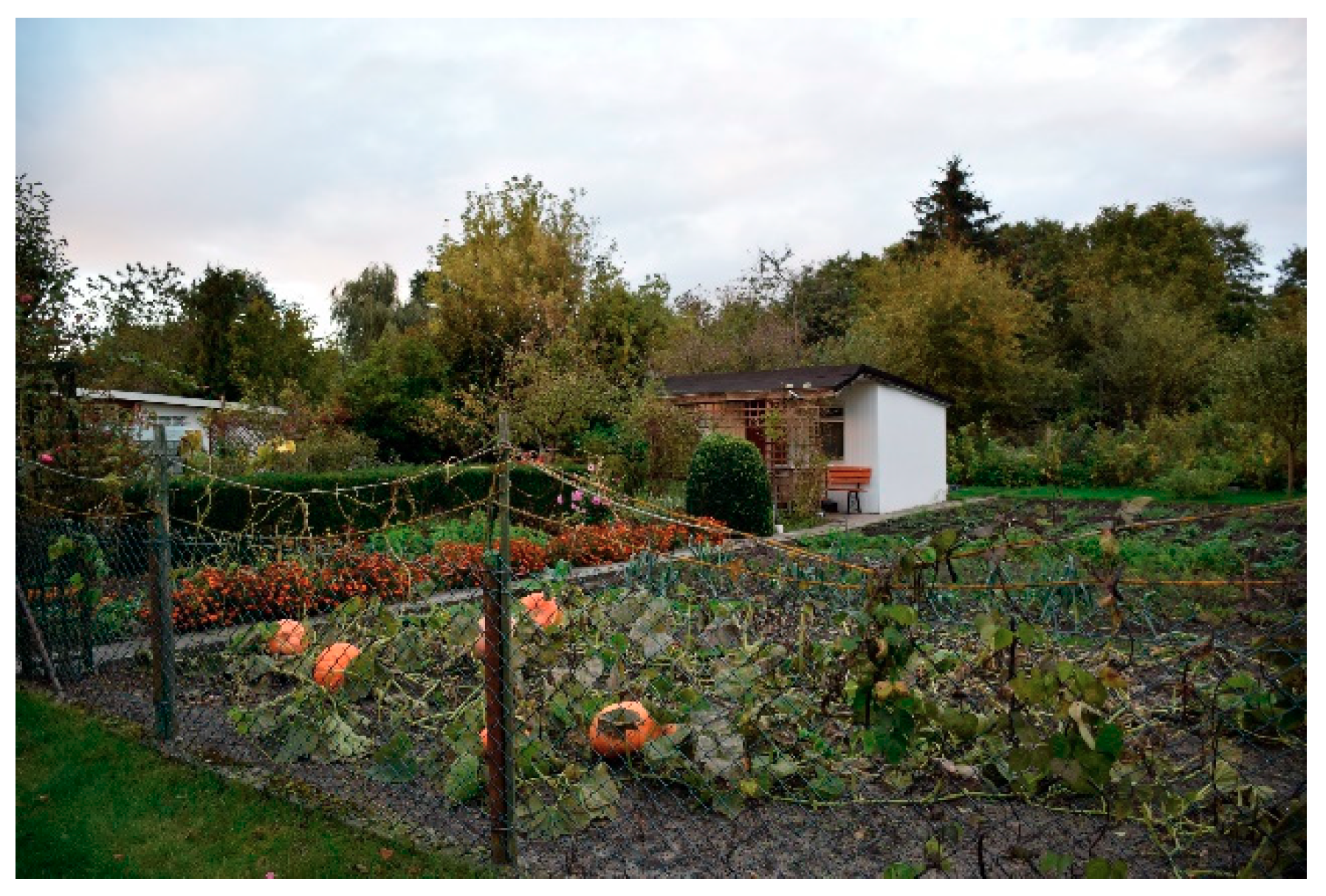
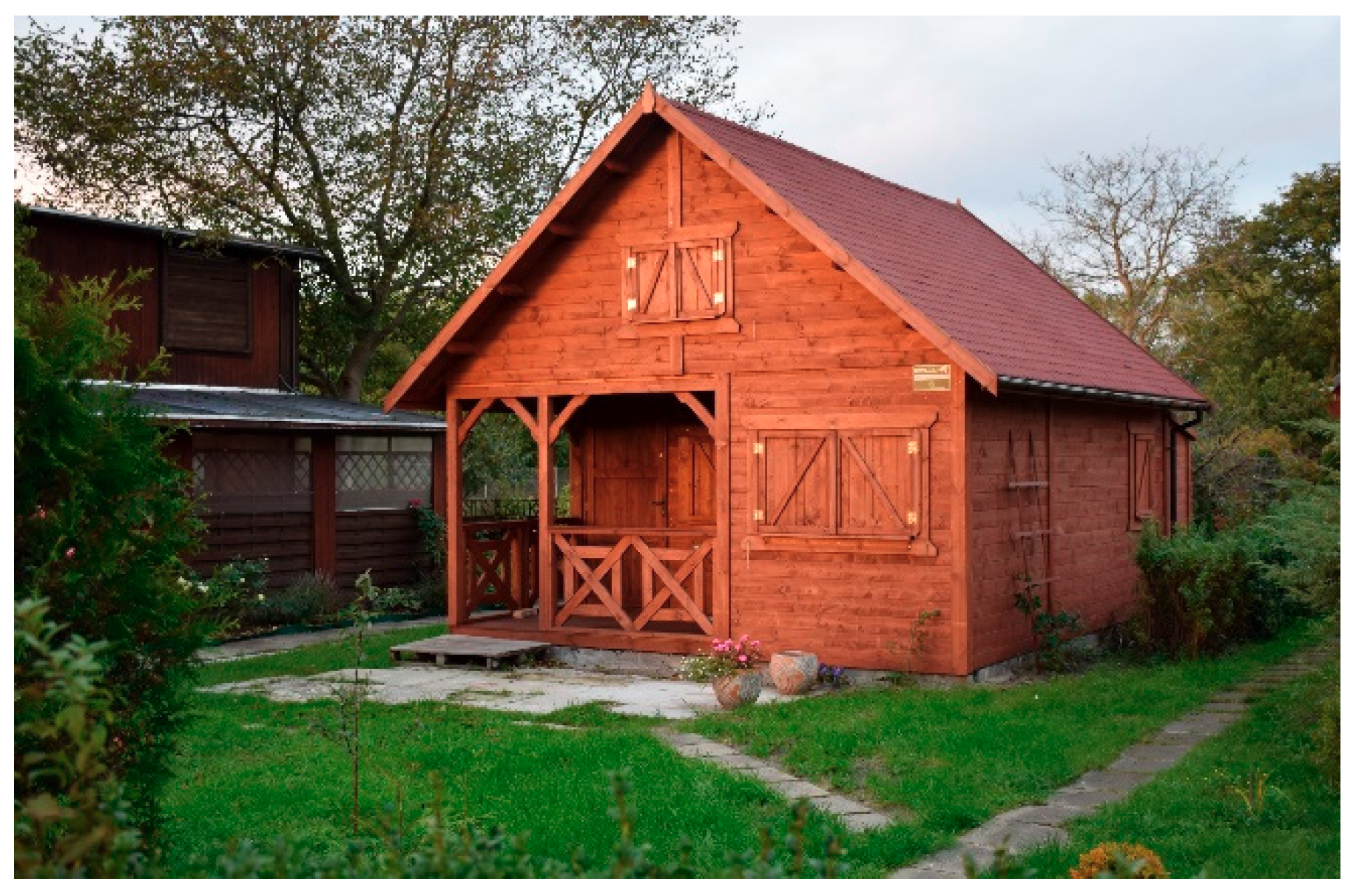
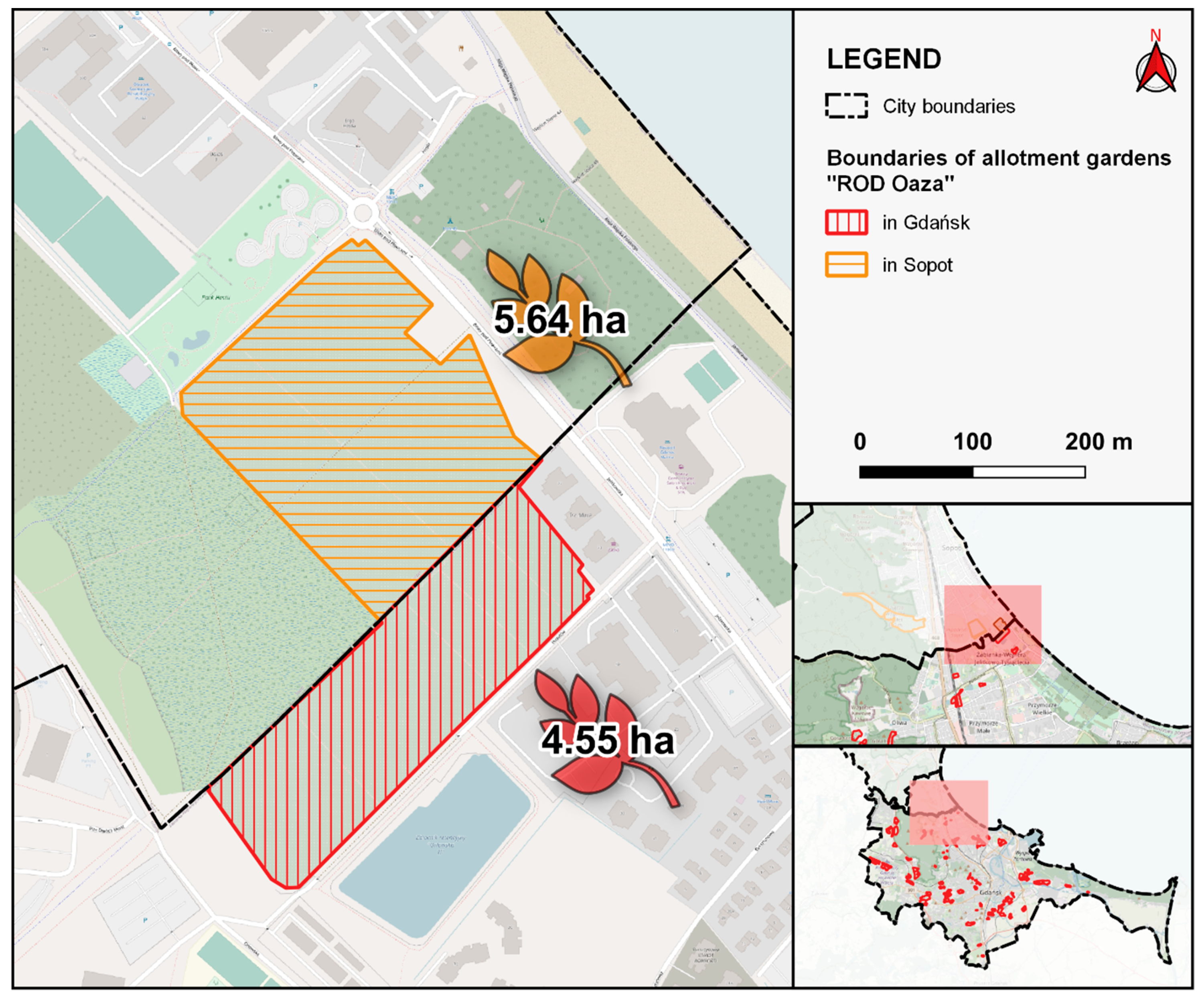
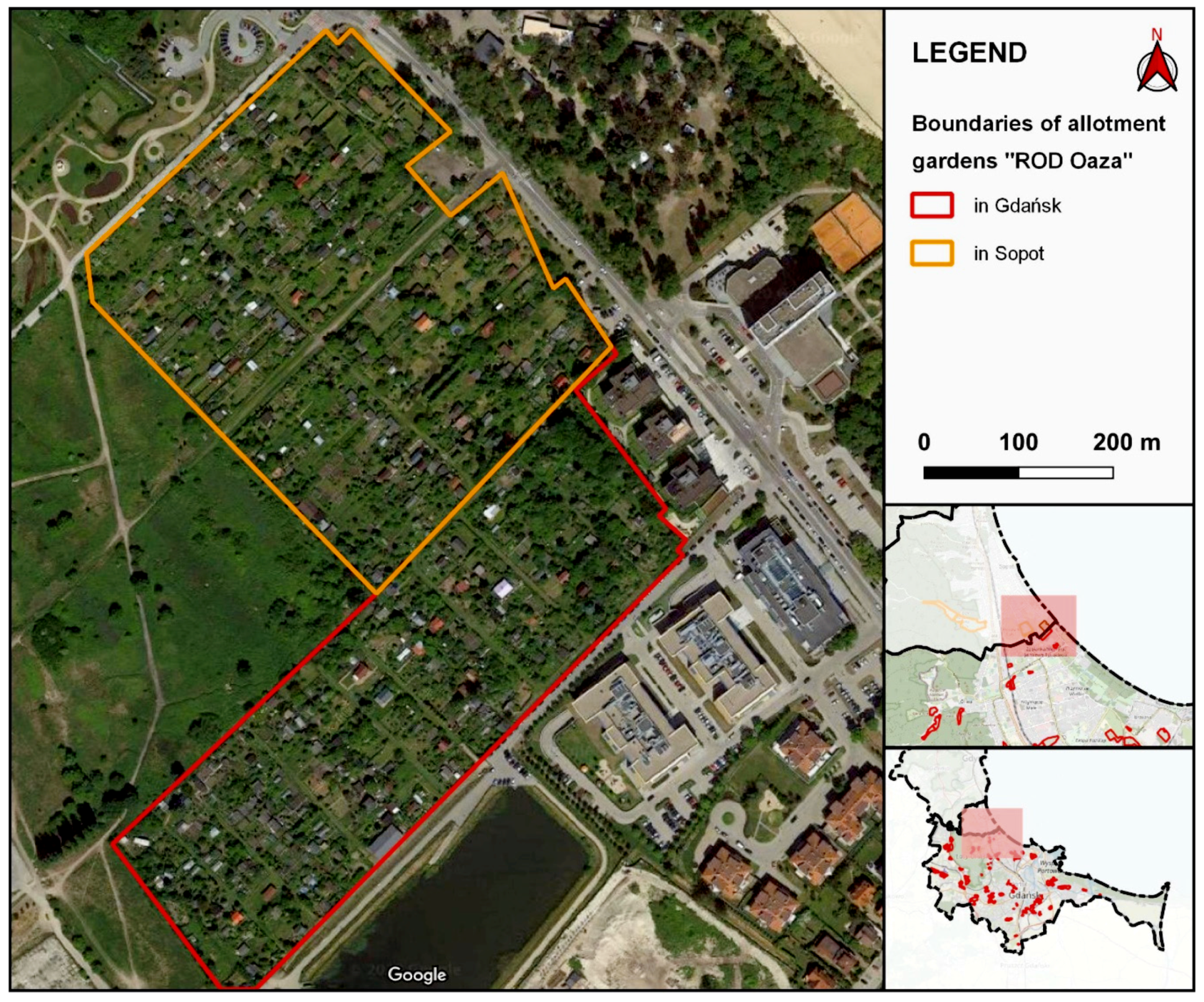
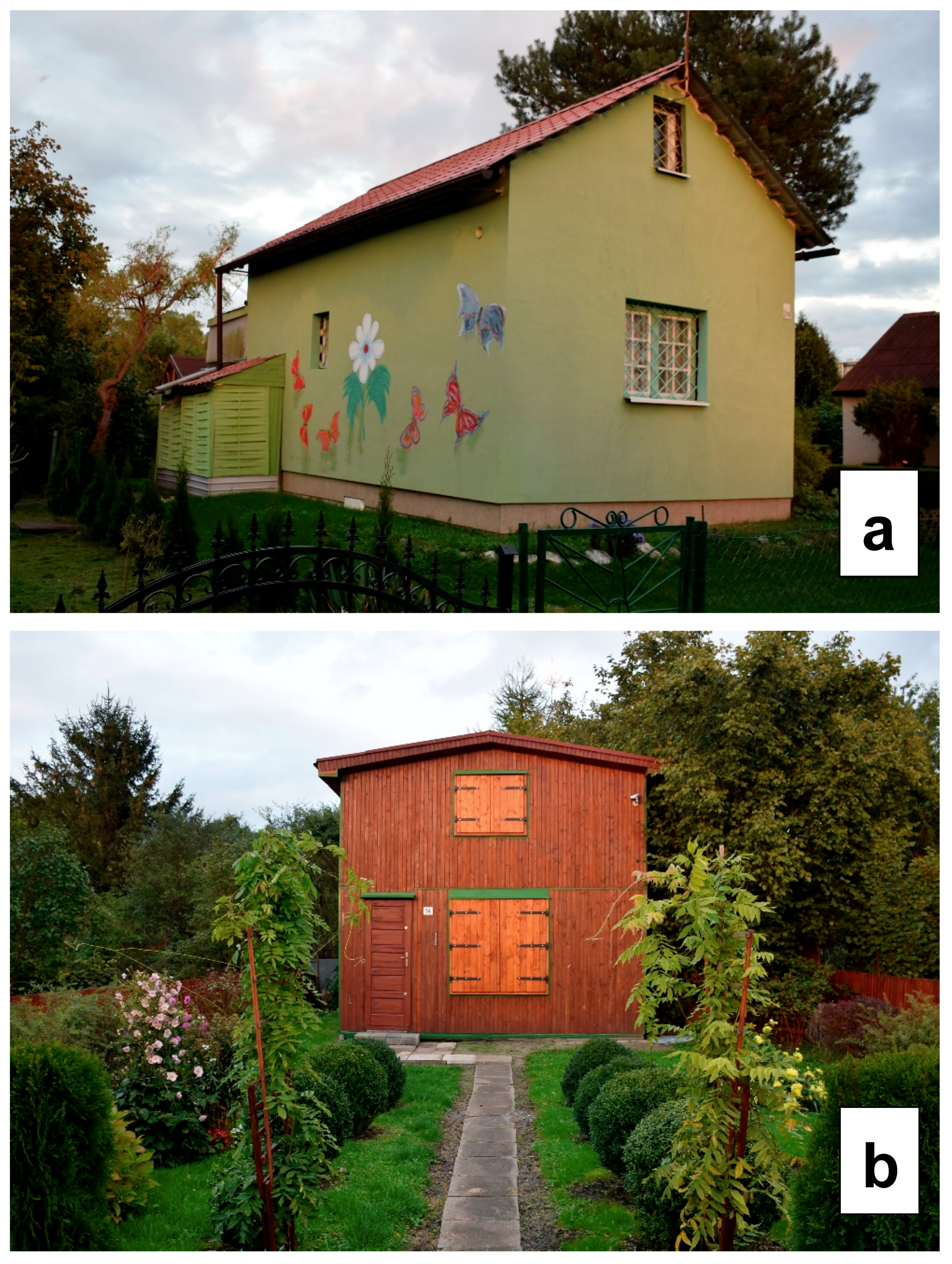
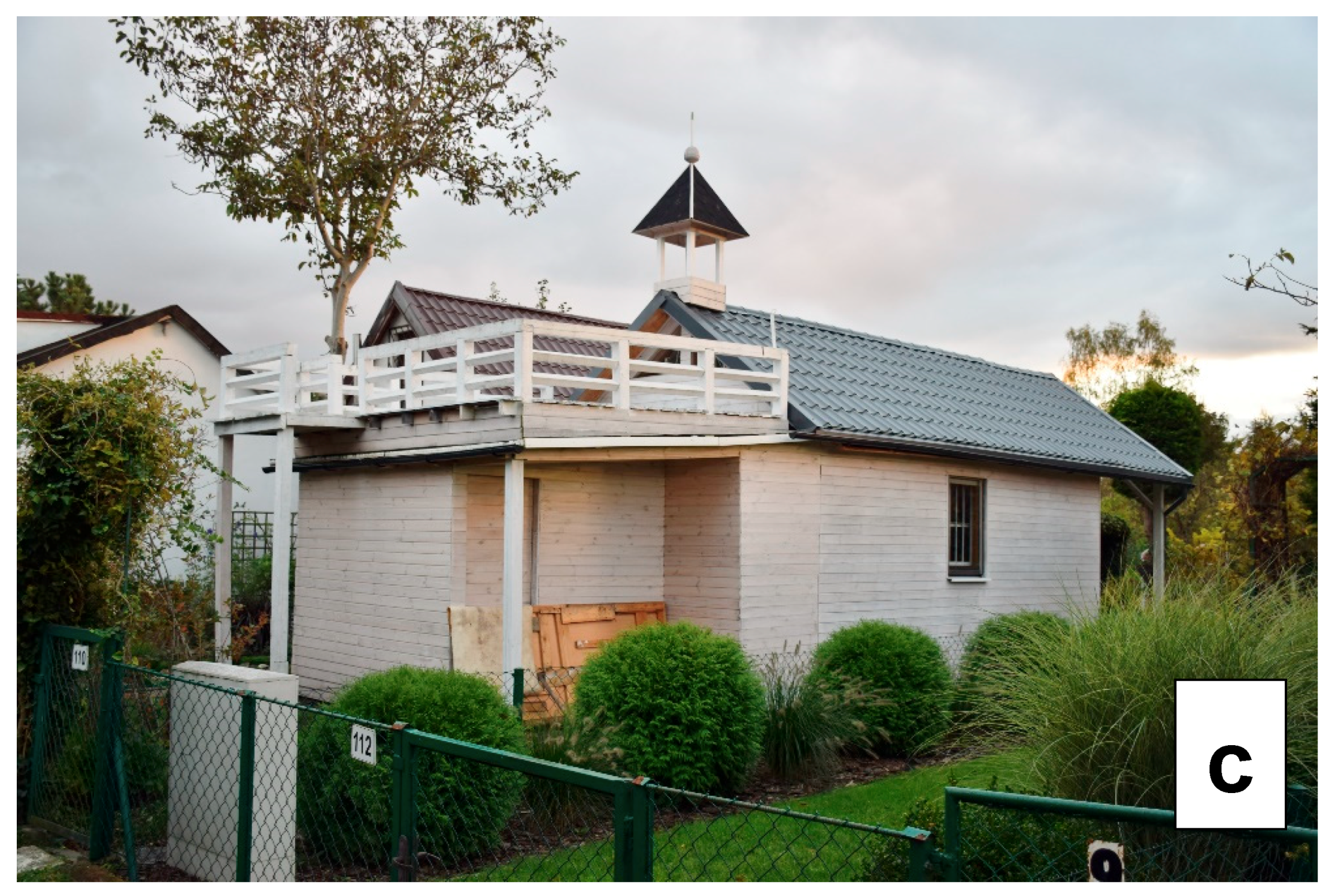
| Issues | Description of Sample Problems |
|---|---|
| Conflicts between garden holders |
|
| Social conflicts |
|
| Non-compliance with the law |
|
| Failure to comply with the regulations of the Family Allotment Gardens |
|
| Unauthorized construction (oversized buildings) |
|
| The phenomenon of “second homes” |
|
| Change of the function |
| Question | Respondent I (89 Years Old) | Respondent II (75 Years Old) | Respondent III (62 Years Old) | |
|---|---|---|---|---|
| 1 | Changes in the functions of allotment gardens |
|
|
|
| 2 | Change of plot owners (older or younger people) |
|
|
|
| 3 | Opinion on new large garden houses with residential functions |
|
|
|
| 4 | Fear that the plot will be taken away by the local government for other investments |
|
|
|
| 5 | Feelings accompanying allotment owners on whether it is still an allotment garden or rather a housing estate |
|
|
|
| 6 | Is there any discussion on land development? |
|
|
|
| 7 | Is having a new large garden house associated with difficulties | n/a | n/a |
|
Publisher’s Note: MDPI stays neutral with regard to jurisdictional claims in published maps and institutional affiliations. |
© 2020 by the authors. Licensee MDPI, Basel, Switzerland. This article is an open access article distributed under the terms and conditions of the Creative Commons Attribution (CC BY) license (http://creativecommons.org/licenses/by/4.0/).
Share and Cite
Moskalonek, Ż.; Połom, M.; Puzdrakiewicz, K. Changes in the Function of Allotment Gardens in an Attractive Location Based on the Example of Tri-City in Poland. Land 2020, 9, 464. https://doi.org/10.3390/land9110464
Moskalonek Ż, Połom M, Puzdrakiewicz K. Changes in the Function of Allotment Gardens in an Attractive Location Based on the Example of Tri-City in Poland. Land. 2020; 9(11):464. https://doi.org/10.3390/land9110464
Chicago/Turabian StyleMoskalonek, Żaneta, Marcin Połom, and Krystian Puzdrakiewicz. 2020. "Changes in the Function of Allotment Gardens in an Attractive Location Based on the Example of Tri-City in Poland" Land 9, no. 11: 464. https://doi.org/10.3390/land9110464
APA StyleMoskalonek, Ż., Połom, M., & Puzdrakiewicz, K. (2020). Changes in the Function of Allotment Gardens in an Attractive Location Based on the Example of Tri-City in Poland. Land, 9(11), 464. https://doi.org/10.3390/land9110464







